Peer Effects on Vocabulary Knowledge: A Linear Quantile Mixed-Modeling Approach
Abstract
1. Introduction
1.1. What are Peer Effects?
1.2. Why Are Peer Achievement Effects Inconsistent?
1.3. Specific Peer Achievement Effects on Language Outcomes
1.4. The Present Study
“…we have seen that the data consistently rejects the Linear-in-Means model as a standalone explanation of peer effects. Thus, researchers’ common reliance on the Linear-in-Means model guarantees that any effects of peers that operate non-linearly or through moments other than the mean become omitted variables.”[8] (p. 29)
Research Questions
- What are the effects of group-level peer achievement on individual-level vocabulary achievement at each of grades K-2 after controlling for race/ethnicity and free-or-reduced lunch status?
- Controlling for individual levels of vocabulary achievement in the fall, are there moderating effects of peer characteristics, such as group-level IEP status or disability status, in the classroom on end-of-year individual-level vocabulary outcomes at each of grades K-2?
- Are there differences in the relations of and interactions between these predictor variables (i.e., fall achievement levels, peer group achievement, and group-level IEP or disability status) across quantiles of the conditional distribution of vocabulary outcomes at each of grades K-2?
- Are there grade-related differences in how peers’ achievement and group-level IEP or disability status affects individual-level performance on end-of-year vocabulary achievement?
2. Materials and Methods
2.1. Data
2.2. Participants
2.3. Measures
2.3.1. Vocabulary
2.3.2. Peer Effects and Relative Status
2.4. Analysis
2.4.1. Identifying Peers
2.4.2. Hierarchical Linear Modeling (HLM)
2.4.3. Linear Quantile Mixed Modeling (LQMM)
3. Results
3.1. Descriptive Statistics
3.2. HLM Results
Conditional Model Effects
3.3. LQMM Results
3.3.1. Kindergarten
3.3.2. First Grade
3.3.3. Second Grade
3.4. Summary
4. Discussion
4.1. Peer-Level Achievement Effects on Individual-Level Vocabulary Achievement
Disability Status
4.2. Limitations
4.2.1. School Reassignment and Peer Effects
4.2.2. Theoretical and Empirical Difficulties in Measuring Peer Effects
4.2.3. Missing Variables that Might Further Affect Individual-Level Achievement
4.3. Implications and Future Directions
5. Conclusions
Supplementary Materials
Author Contributions
Funding
Conflicts of Interest
Appendix A
| β | SE | df | t | |
|---|---|---|---|---|
| Fixed Effects | ||||
| Intercept | 0.020 | 0.005 | 7777 | 3.832 *** |
| RS | 0.551 | 0.002 | 8981 | 269.188 *** |
| IEP | −0.138 | 0.007 | 7527 | −18.587 *** |
| PM | 0.438 | 0.006 | 2782 | 77.042 *** |
| PSD | 0.004 | 0.005 | 3425 | 0.707 |
| PIEPS | −0.002 | 0.005 | 1996 | −0.320 |
| IEPxRS | 0.041 | 0.006 | 45,890 | 6.544 *** |
| IEPxPM | 0.006 | 0.006 | 4846 | 0.924 |
| IEPxPSD | −0.015 | 0.006 | 4702 | −2.476 * |
| IEPxPIEPS | −0.016 | 0.005 | 2441 | −2.846 |
| RSxPM | −0.027 | 0.002 | 7573 | −13.804 *** |
| RSxPSD | 0.126 | 0.002 | 7846 | 63.711 *** |
| RSxPIEPS | −0.001 | 0.002 | 10,630 | −0.296 |
| Random effects | ||||
| Var. | SD | Χ2 (df = 6) | ||
| Intercept | 0.168 | 0.410 | ||
| RS | 0.009 | 0.097 | 782.1 *** | |
| IEP | 0.014 | 0.117 | 47.0 *** | |
| pm | 0.021 | 0.146 | 355.4 *** | |
| sd | 0.006 | 0.079 | 34.6 *** | |
| IEPZ | 0.001 | 0.027 | 21.8 ** | |
| Residual | 0.291 | 0.539 | ||
| β | SE | df | t | ||
|---|---|---|---|---|---|
| Fixed Effects | |||||
| Intercept | 0.006 | 0.005 | 6998 | 1.375 | |
| RS | 0.558 | 0.002 | 8751 | 257.864 *** | |
| IEP | −0.111 | 0.007 | 7512 | −15.248 *** | |
| PM | 0.468 | 0.005 | 3029 | 91.278 *** | |
| PSD | 0.021 | 0.005 | 3473 | 4.268 *** | |
| PIEPS | −0.015 | 0.005 | 1982 | −3.244 ** | |
| IEPxRS | 0.047 | 0.006 | 51,300 | 7.536 *** | |
| IEPxPM | 0.002 | 0.006 | 4833 | 0.379 | |
| IEPxPSD | −0.018 | 0.006 | 4636 | −3.021 ** | |
| IEPxPIEPS | 0.005 | 0.006 | 2716 | 0.803 | |
| RSxPM | −0.051 | 0.002 | 7165 | −24.841 *** | |
| RSxPSD | 0.119 | 0.002 | 7308 | 57.967 *** | |
| RSxPIEPS | 0.001 | 0.002 | 10,000 | 0.505 | |
| Random effects | |||||
| Var. | SD | Χ2 (df = 6) | |||
| Intercept | 0.112 | 0.335 | |||
| RS | 0.008 | 0.092 | 558.0 *** | ||
| IEP | 0.011 | 0.104 | 35.7 *** | ||
| pm | 0.017 | 0.131 | 282.4 *** | ||
| sd | 0.008 | 0.087 | 119.8 *** | ||
| IEPZ | 0.004 | 0.065 | 59.7 *** | ||
| Residual | 0.311 | 0.558 | |||
| β | SE | df | t | ||
|---|---|---|---|---|---|
| Fixed Effects | |||||
| Intercept | 0.022 | 0.006 | 6718 | 3.943 *** | |
| RS | 0.484 | 0.002 | 8138 | 200.374 *** | |
| IEP | −0.177 | 0.008 | 7031 | −22.330 *** | |
| PM | 0.438 | 0.006 | 2504 | 73.096 *** | |
| PSD | 0.013 | 0.006 | 2677 | 2.302 * | |
| PIEPS | −0.008 | 0.006 | 1678 | −1.422 | |
| IEPxRS | 0.070 | 0.007 | 52,240 | 10.516 *** | |
| IEPxPM | 0.010 | 0.007 | 4825 | 1.503 | |
| IEPxPSD | −0.011 | 0.007 | 4620 | −1.692 | |
| IEPxPIEPS | −0.020 | 0.006 | 3057 | −3.191 ** | |
| RSxPM | −0.059 | 0.002 | 6522 | −26.032 *** | |
| RSxPSD | 0.115 | 0.002 | 6710 | 50.200 *** | |
| RSxPIEPS | 0.000 | 0.002 | 8587 | 0.131 | |
| Random effects | |||||
| Var. | SD | Χ2 (df = 6) | |||
| Intercept | 0.170 | 0.412 | |||
| RS | 0.009 | 0.097 | 641.3 *** | ||
| IEP | 0.020 | 0.143 | 103.1 *** | ||
| pm | 0.014 | 0.119 | 140.5 *** | ||
| sd | 0.004 | 0.066 | 40.6 *** | ||
| IEPZ | 0.002 | 0.044 | 10.2 | ||
| Residual | 0.357 | 0.597 | |||
References
- Hoxby, C. Peer Effects in the Classroom: Learning from Gender and Race Variation; Working Paper 7867; National Bureau of Economic Research: Cambridge, MA, USA, 2000; Available online: http://www.nber.org/papers/w7867.pdf (accessed on 22 October 2018).
- Zimmer, R.W.; Toma, E.F. Peer Effects in Private and Public Schools across Countries. J. Policy Anal. Manag. 2000, 19, 75–92. [Google Scholar] [CrossRef]
- Hattie, J.A.C. Classroom Composition and Peer Effects. Int. J. Educ. Res. 2002, 37, 449–481. [Google Scholar] [CrossRef]
- Coleman, J.S.; Campbell, E.Q.; Hobson, C.J.; McPartland, J.; Mood, A.M.; Weinfeld, F.D.; York, R.L. Equality of Educational Opportunity; OE-38001; National Center for Education Statistics: Washington, DC, USA, 1966; p. 746.
- Willms, J.D. Monitoring School Performance: A Guide for Educators; Routledge: Abingdon, UK, 2003. [Google Scholar]
- Dar, Y.; Resh, N. Classroom Intellectual Composition and Academic Achievement. Am. Educ. Res. J. 1986, 23, 357–374. [Google Scholar] [CrossRef]
- Leiter, J. Classroom Composition and Achievement Gains. Sociol. Educ. 1983, 56, 126–132. [Google Scholar] [CrossRef]
- Hoxby, C.M.; Weingarth, G. Taking Race out of the Equation: School Reassignment and the Structure of Peer Effects; Working Paper 7867; Harvard University: Cambridge, MA, USA, 2003; p. 47. [Google Scholar]
- Thrupp, M.; Lauder, H.; Robinson, T. School Composition and Peer Effects. Int. J. Educ. Res. 2002, 37, 483–504. [Google Scholar] [CrossRef]
- Wilkinson, I.A.G.; Parr, J.M.; Fung, I.Y.Y.; Hattie, J.A.C.; Townsend, M.A.R. Discussion: Modeling and Maximizing Peer Effects in School. Int. J. Educ. Res. 2002, 37, 521–535. [Google Scholar] [CrossRef]
- Sacerdote, B. Peer Effects in Education: How Might They Work, How Big Are They and How Much Do We Know Thus Far? In Handbook of the Economics of Education; Hanushek, E.A., Machin, S., Woessmann, L., Eds.; Elsevier: Amsterdam, The Netherlands, 2011; Volume 3, pp. 249–277. [Google Scholar]
- Bryan, T.H. Peer Popularity of Learning Disabled Children: A Replication. J. Learn. Disabil. 1976, 9, 307–311. [Google Scholar] [CrossRef]
- Vaughn, S.; Elbaum, B.E.; Schumm, J.S. The Effects of Inclusion on the Social Functioning of Students with Learning Disabilities. J. Learn. Disabil. 1996, 29, 599–608. [Google Scholar] [CrossRef]
- Burke, M.A.; Sass, T.R. Classroom Peer Effects and Student Achievement. J. Labor. Econ. 2013, 31, 51–82. [Google Scholar] [CrossRef]
- De Fraine, B.D.; Damme, J.V.; Landeghem, G.V.; Opdenakker, M.-C.; Onghena, P. The Effect of Schools and Classes on Language Achievement. Br. Educ. Res. J. 2003, 29, 841–859. [Google Scholar] [CrossRef]
- Peetsma, T.; van der Veen, I.; Koopman, P.; van Schooten, E. Class Composition Influences on Pupils’ Cognitive Development. Sch. Eff. Sch. Improv. 2006, 17, 275–302. [Google Scholar] [CrossRef]
- Foorman, B.R.; Petscher, Y.; Herrera, S. Unique and Common Effects of Decoding and Language Factors in Predicting Reading Comprehension in Grades 1–10. Learn. Individ. Differ. 2018, 63, 12–23. [Google Scholar] [CrossRef]
- Guo, Y.; Tompkins, V.; Justice, L.; Petscher, Y. Classroom Age Composition and Vocabulary Development Among At-Risk Preschoolers. Early Educ. Dev. 2014, 25, 1016–1034. [Google Scholar] [CrossRef] [PubMed]
- Quinn, J.M.; Wagner, R.K.; Petscher, Y.; Lopez, D. Developmental Relations between Vocabulary Knowledge and Reading Comprehension: A Latent Change Score Modeling Study. Child Dev. 2015, 86, 159–175. [Google Scholar] [CrossRef] [PubMed]
- Kim, Y.-S. Language and Cognitive Predictors of Text Comprehension: Evidence from Multivariate Analysis. Child Dev. 2015, 86, 128–144. [Google Scholar] [CrossRef] [PubMed]
- Kim, Y.-S.G. Direct and Mediated Effects of Language and Cognitive Skills on Comprehension of Oral Narrative Texts (Listening Comprehension) for Children. J. Exp. Child Psychol. 2016, 141, 101–120. [Google Scholar] [CrossRef] [PubMed]
- Perfetti, C. Reading Ability: Lexical Quality to Comprehension. Sci. Stud. Read. 2007, 11, 357–383. [Google Scholar] [CrossRef]
- Perfetti, C.; Hart, L. The Lexical Quality Hypothesis. In Precursors of Functional Literacy; Verhoeven, L.T., Elbro, C., Reitsma, P., Eds.; John Benjamins Publishing: Amsterdam, The Netherlands, 2002; pp. 189–214. ISBN 978-90-272-1806-3. [Google Scholar]
- Henry, G.T.; Rickman, D.K. Do Peers Influence Children’s Skill Development in Preschool? Econ. Educ. Rev. 2007, 26, 100–112. [Google Scholar] [CrossRef]
- Justice, L.M.; Logan, J.A.R.; Lin, T.-J.; Kaderavek, J.N. Peer Effects in Early Childhood Education: Testing the Assumptions of Special-Education Inclusion. Psychol. Sci. 2014, 25, 1722–1729. [Google Scholar] [CrossRef] [PubMed]
- Justice, L.M.; Petscher, Y.; Schatschneider, C.; Mashburn, A. Peer Effects in Preschool Classrooms: Is Children’s Language Growth Associated with Their Classmates’ Skills? Child Dev. 2011, 82, 1768–1777. [Google Scholar] [CrossRef] [PubMed]
- Koenker, R.; Bassett, G. Regression Quantiles. Econometrica 1978, 46, 33–50. [Google Scholar] [CrossRef]
- Petscher, Y. Do Our Means of Inquiry Match Our Intentions? Front. Psychol. 2016, 7. [Google Scholar] [CrossRef] [PubMed]
- Petscher, Y.; Logan, J.A.R. Quantile Regression in the Study of Developmental Sciences. Child Dev. 2014, 85, 861–881. [Google Scholar] [CrossRef] [PubMed]
- Galarza, C.E.; Lachos, V.H. Package ‘qrNLMM’; R Package version 1.4. 2015. Available online: https://cran.r-project.org/package=qrNLMM (accessed on 22 October 2018).
- Galarza, C.E.; Lachos, V.H.; Bandyopadhyay, D. Quantile Regression in Linear Mixed Models: A Stochastic Approximation EM Approach. Stat. Interface 2017, 10, 471–482. [Google Scholar] [CrossRef] [PubMed]
- Geraci, M. Linear Quantile Mixed Models: The Lqmm Package for Laplace Quantile Regression. J. Stat. Softw. 2014, 57, 1–29. [Google Scholar] [CrossRef]
- Geraci, M.; Bottai, M. Linear Quantile Mixed Models. Stat. Comput. 2014, 24, 461–479. [Google Scholar] [CrossRef]
- Florida Department of Education. Florida Assessments for Instruction in Reading Kindergarten—Grade 2 Technical Manual; Florida Department of Education: Tallahassee, FL, USA, 2009. [Google Scholar]
- Williams, K. Expressive Vocabulary Test, 2nd ed.; Pearson: San Antonio, TX, USA, 2007. [Google Scholar]
- Harcourt Brace Educational Measurement. Stanford Achievement Test, 10th ed.; Harcourt Assessment: San Antonio, TX, USA, 2003. [Google Scholar]
- Hoff, E. Interpreting the Early Language Trajectories of Children from Low-SES and Language Minority Homes: Implications for Closing Achievement Gaps. Dev. Psychol. 2013, 49, 4–14. [Google Scholar] [CrossRef] [PubMed]
- Hart, B.; Risley, T.R. Meaningful Differences in the Everyday Experience of Young American Children; Meaningful Differences in the Everyday Experience of Young American Children; Paul H Brookes Publishing: Baltimore, MD, USA, 1995. [Google Scholar]
- Carrell, S.E.; Sacerdote, B.I.; West, J.E. From Natural Variation to Optimal Policy? The Lucas Critique Meets Peer Effects; Working Paper 16865; National Bureau of Economic Research: Cambridge, MA, USA, 2011; Available online: http://www.nber.org/papers/w16865 (accessed on 22 October 2018).
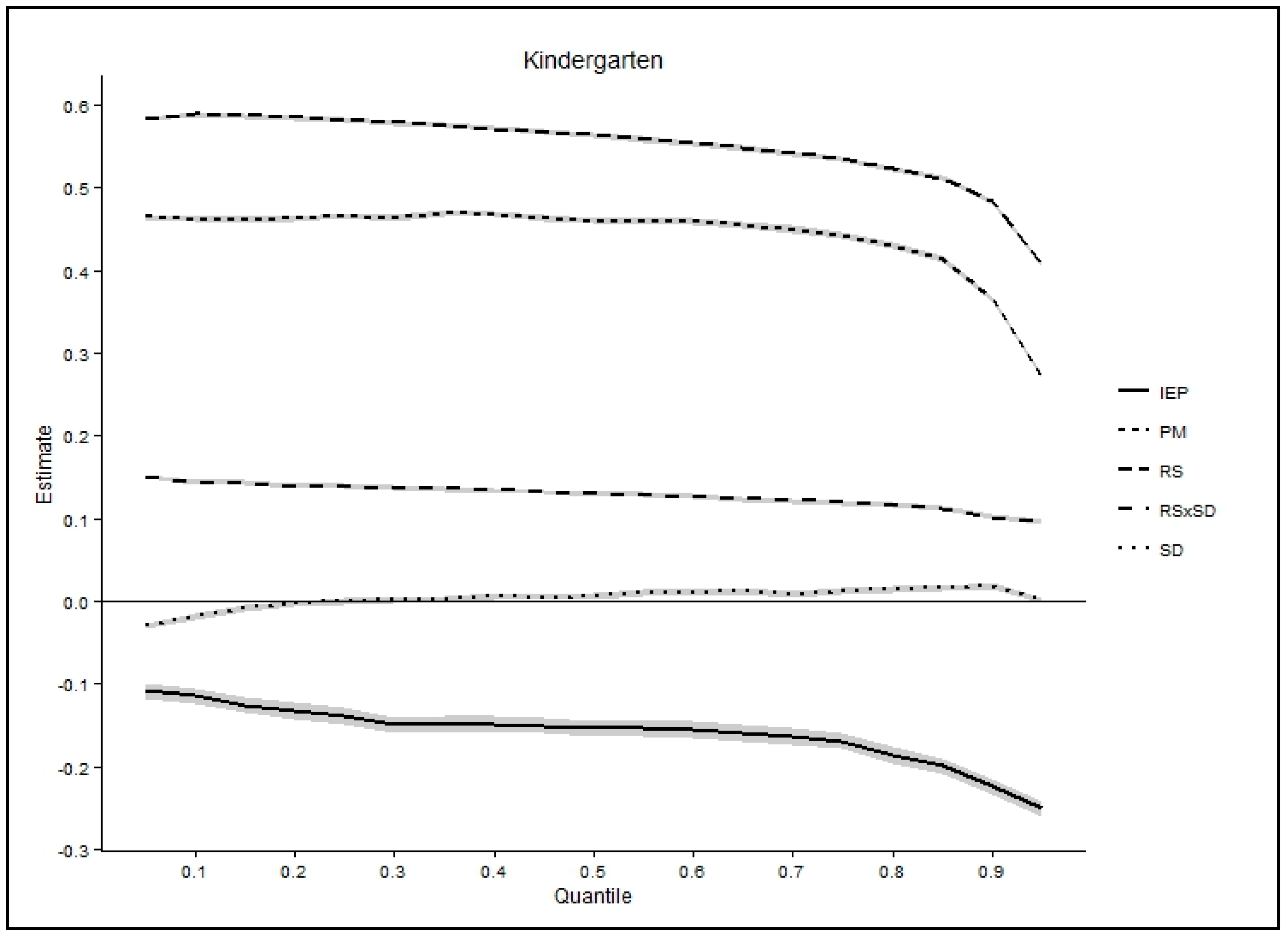
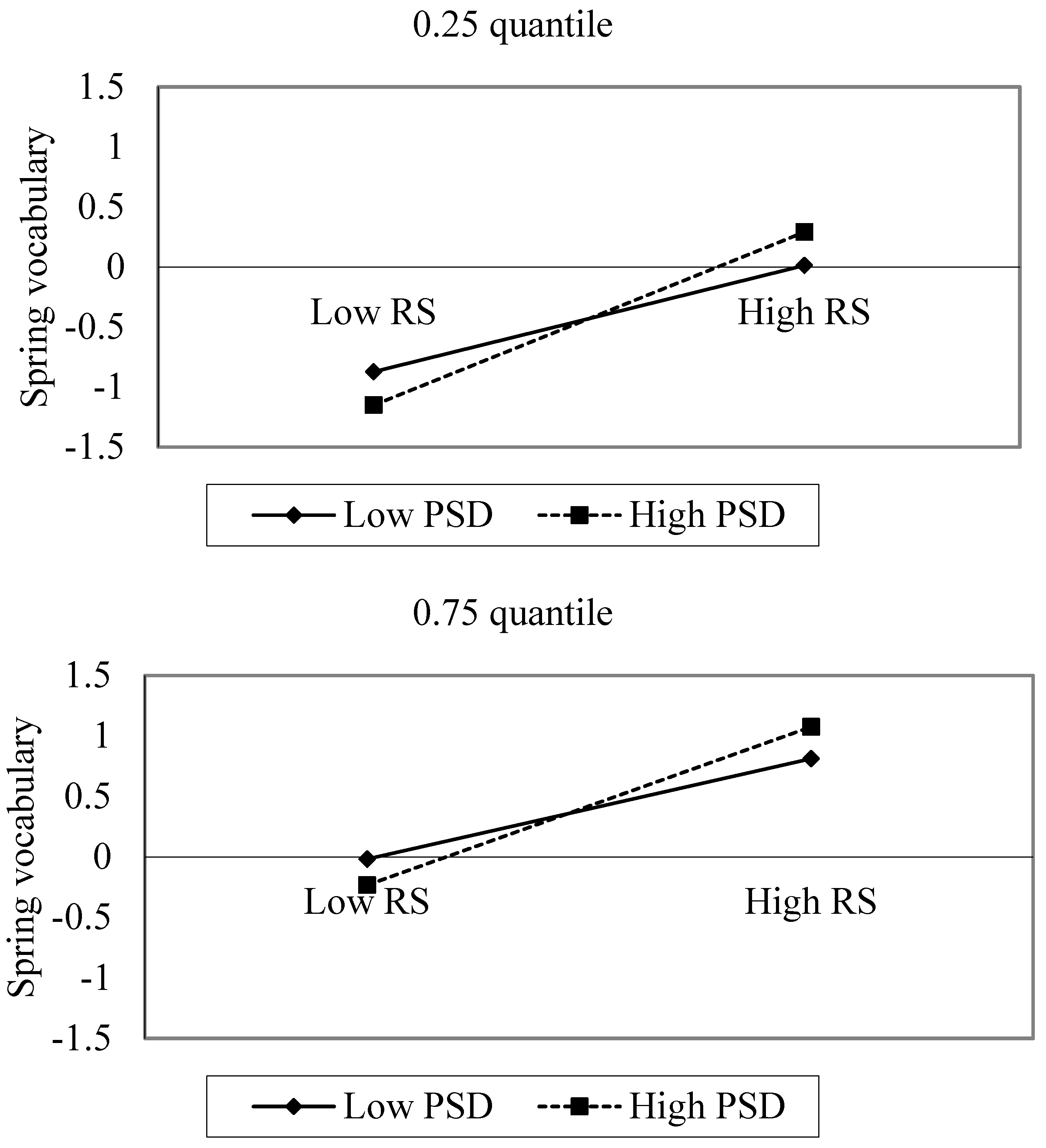
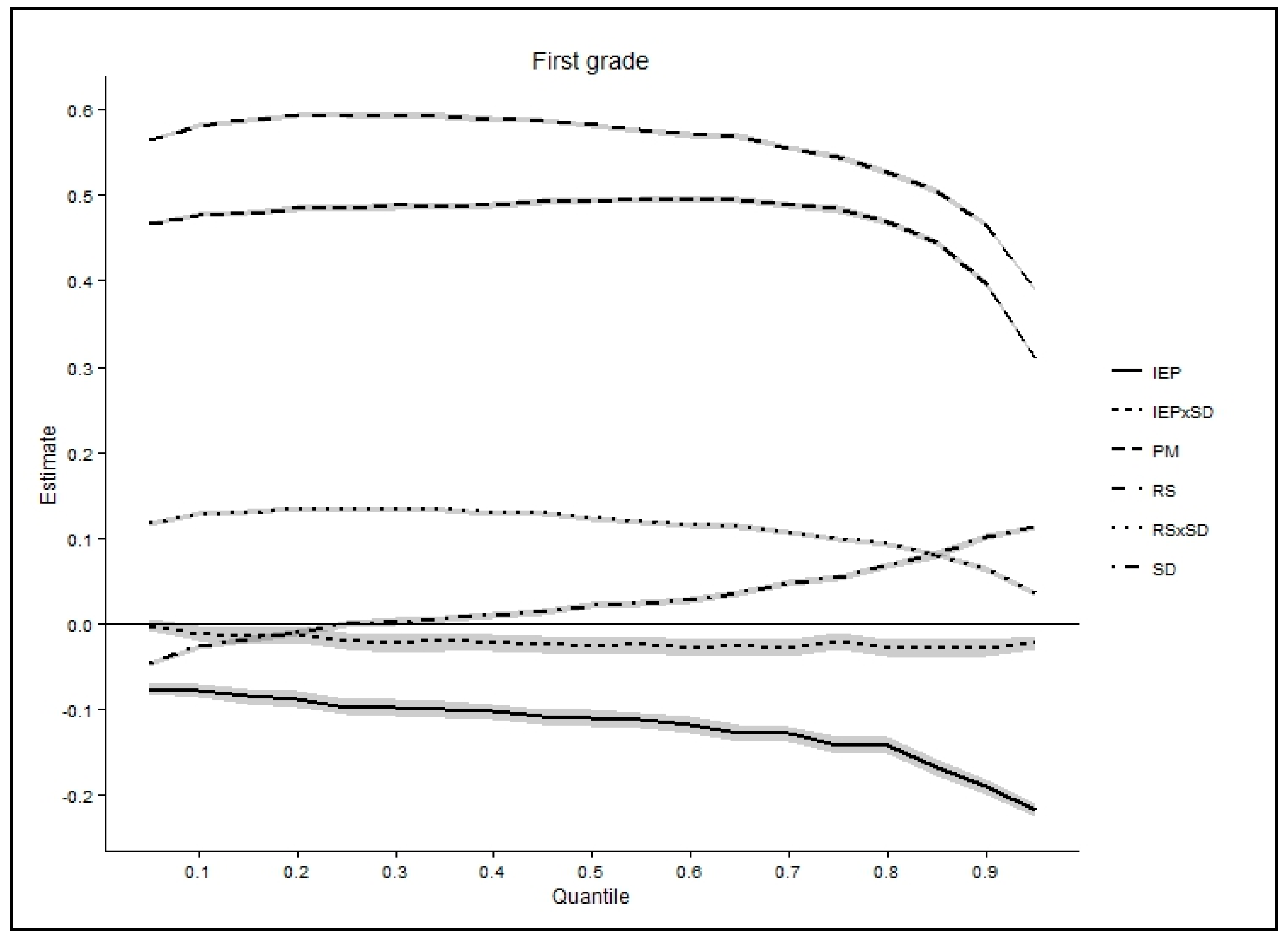
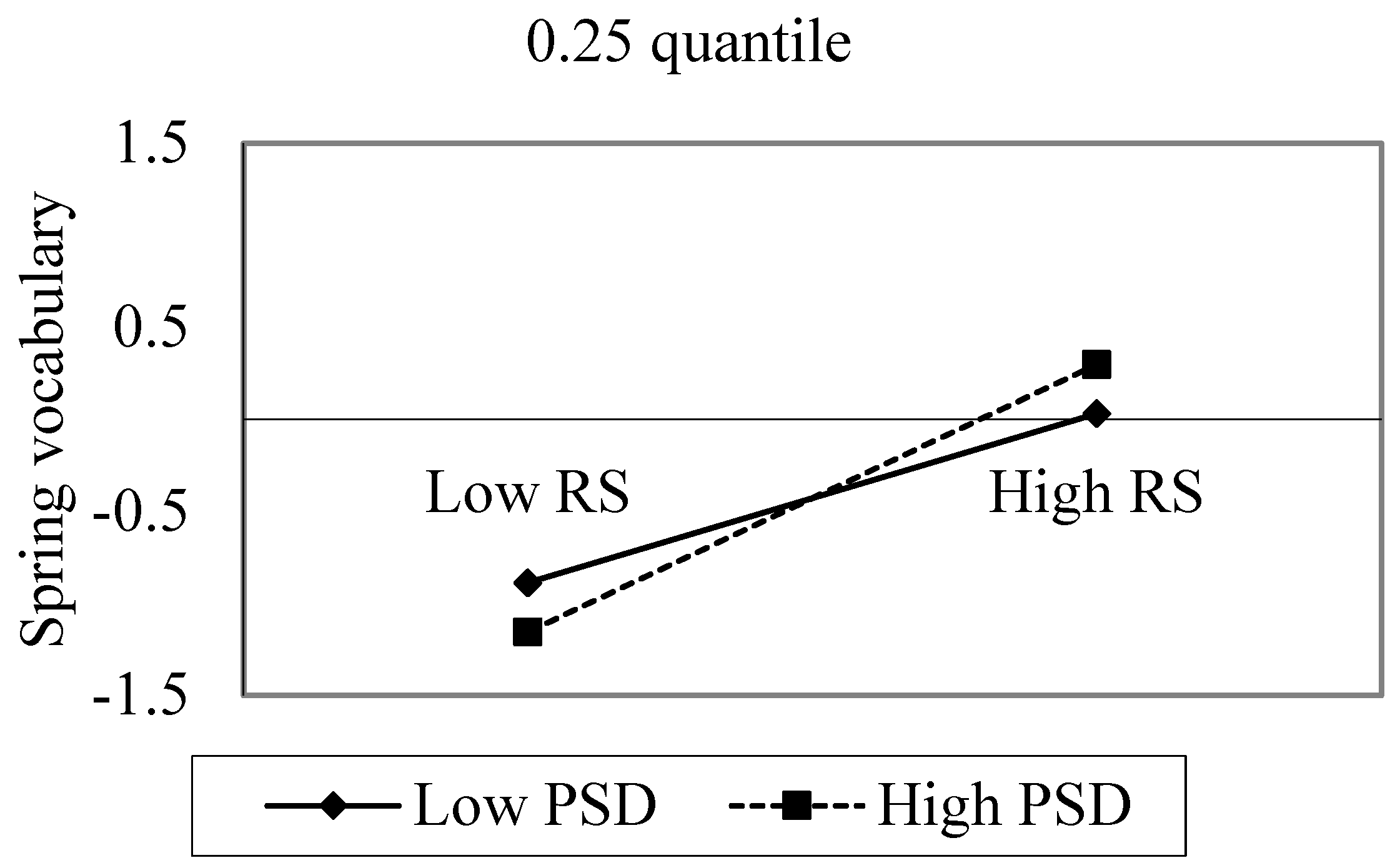
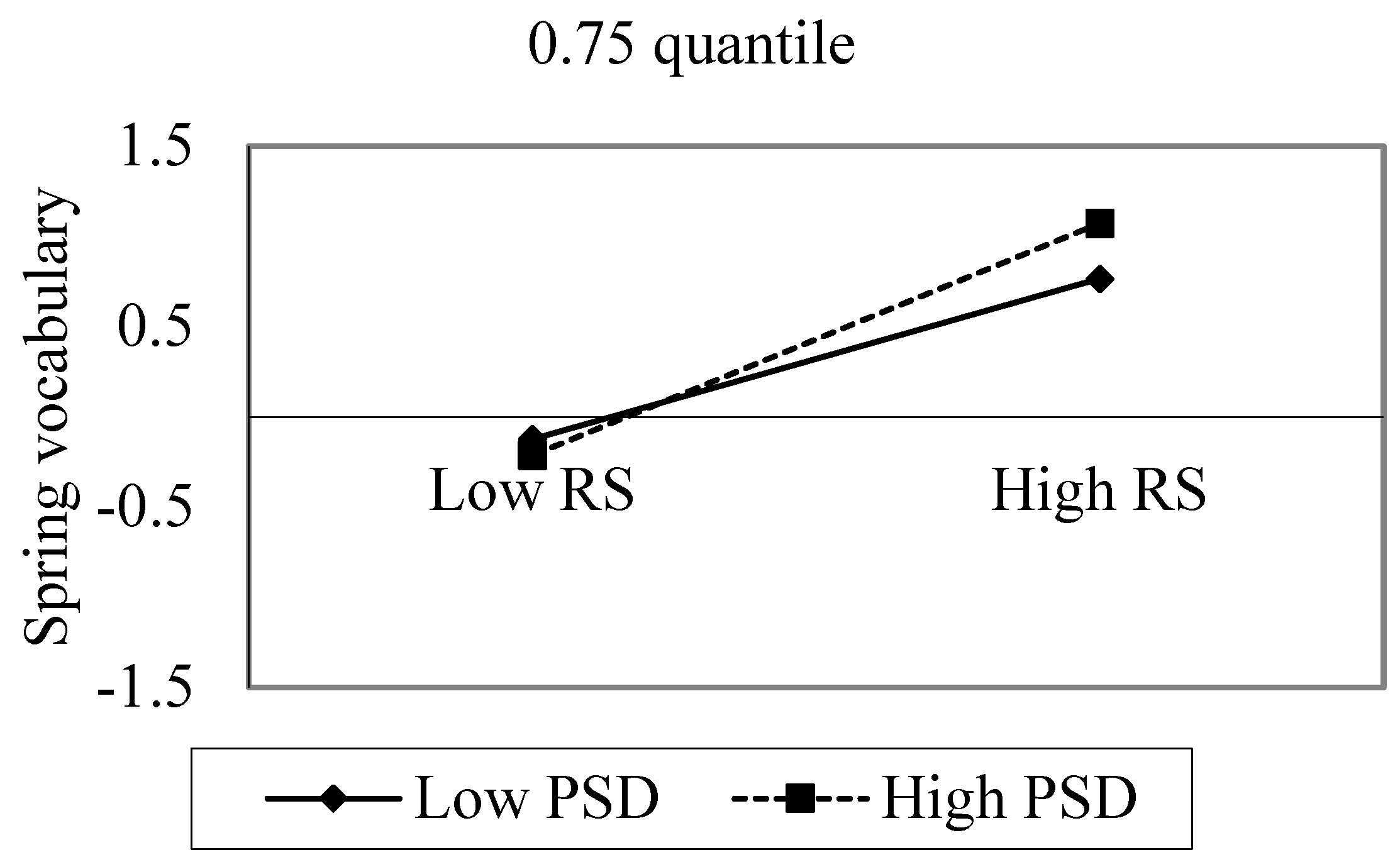
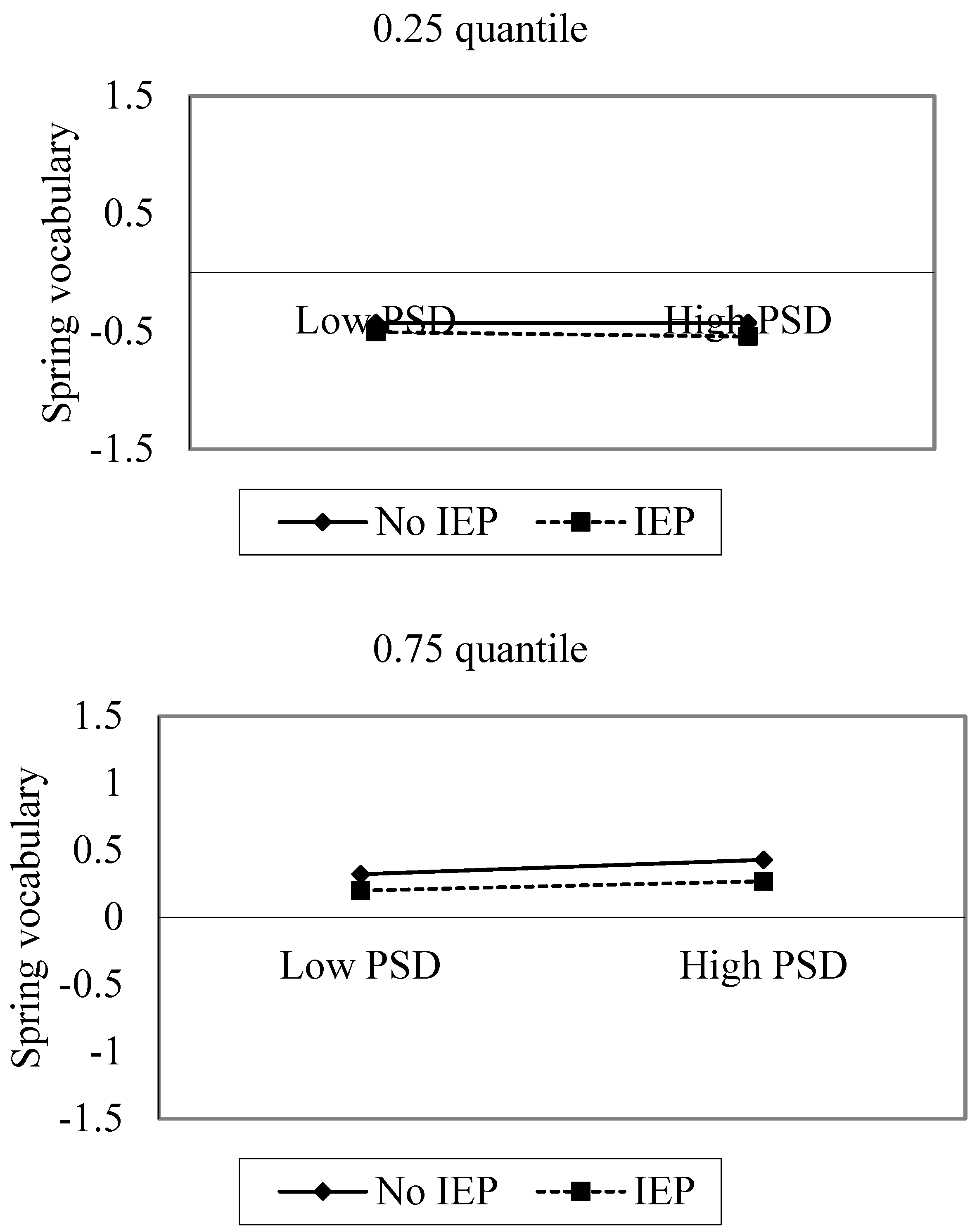
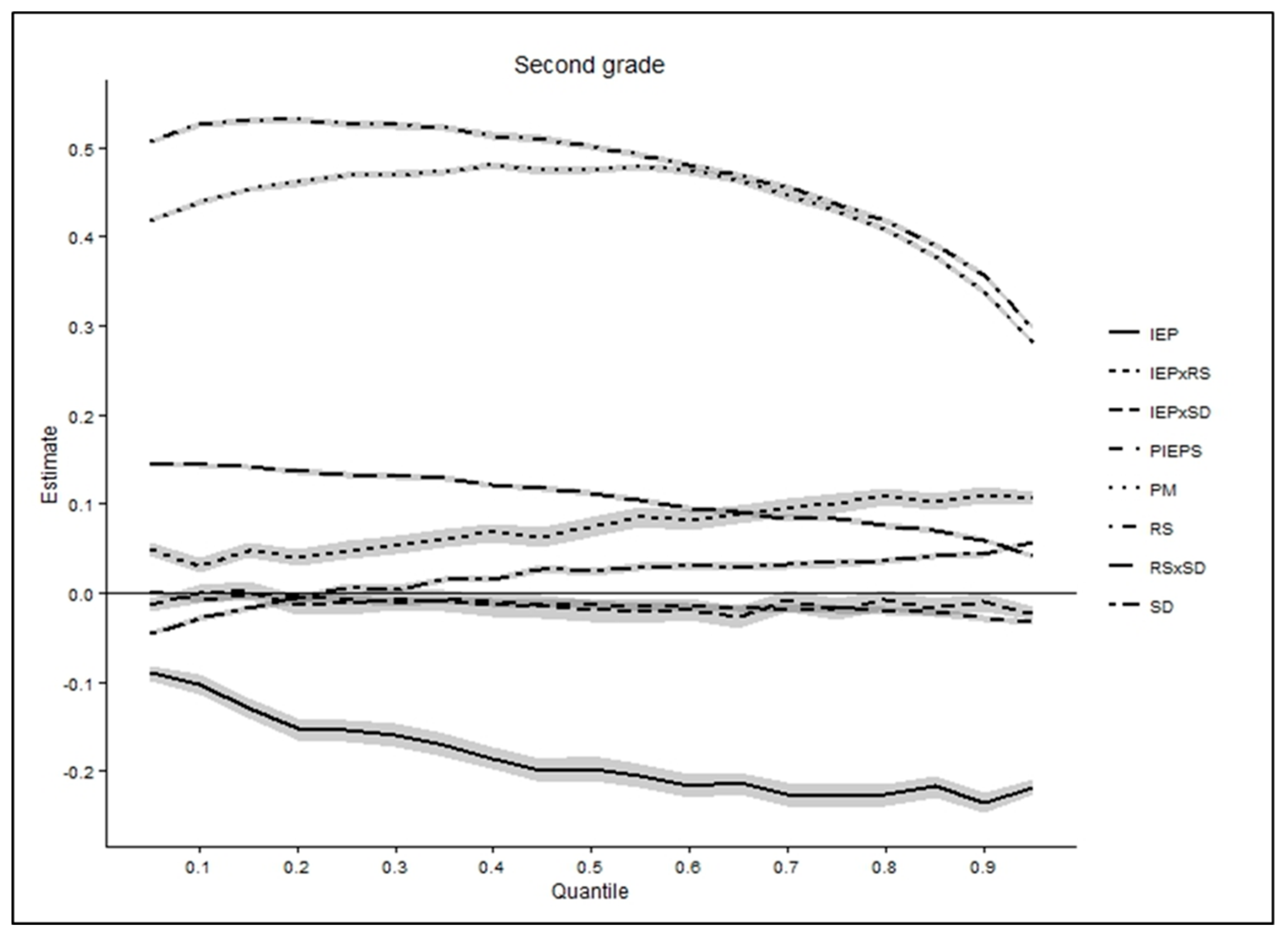
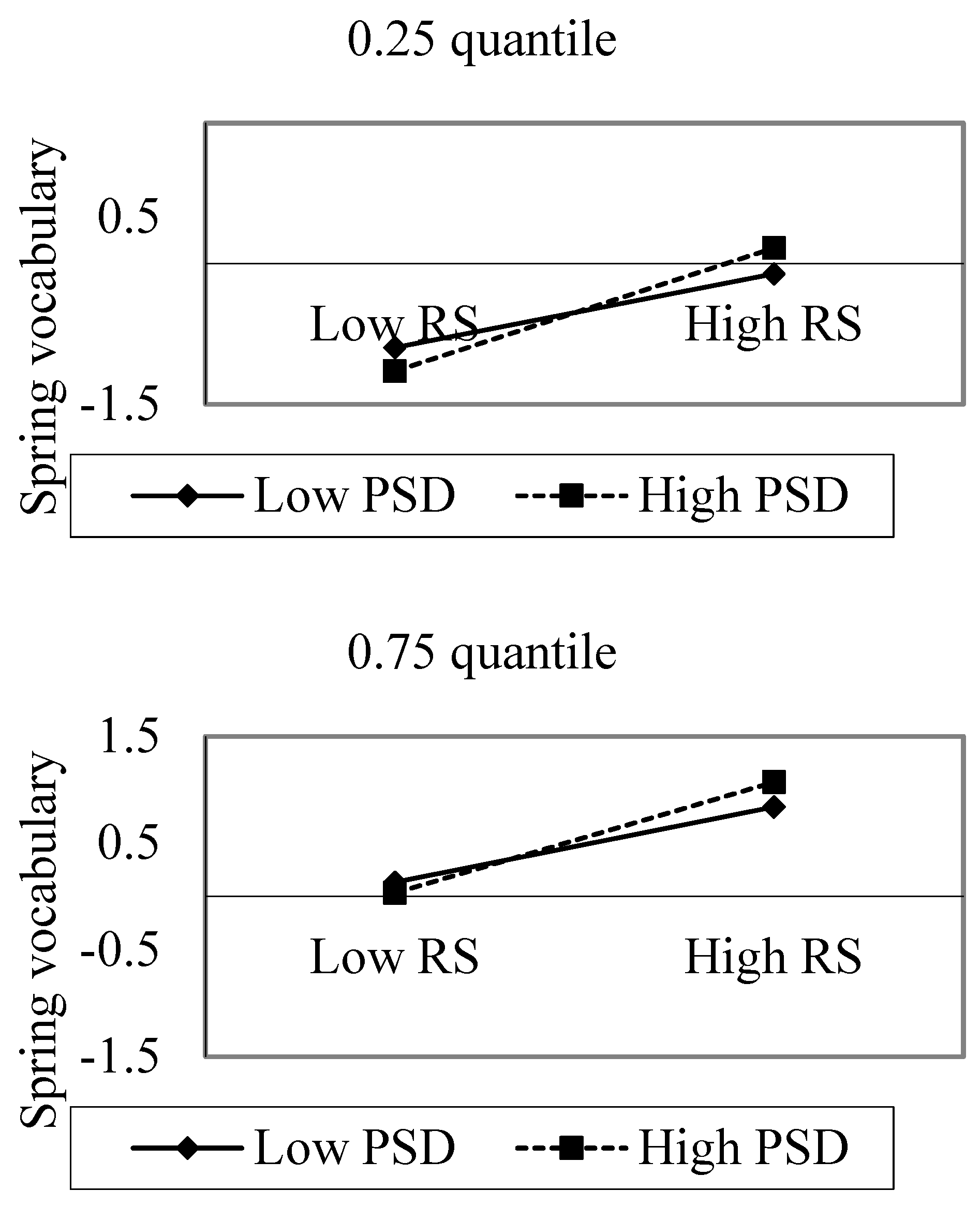
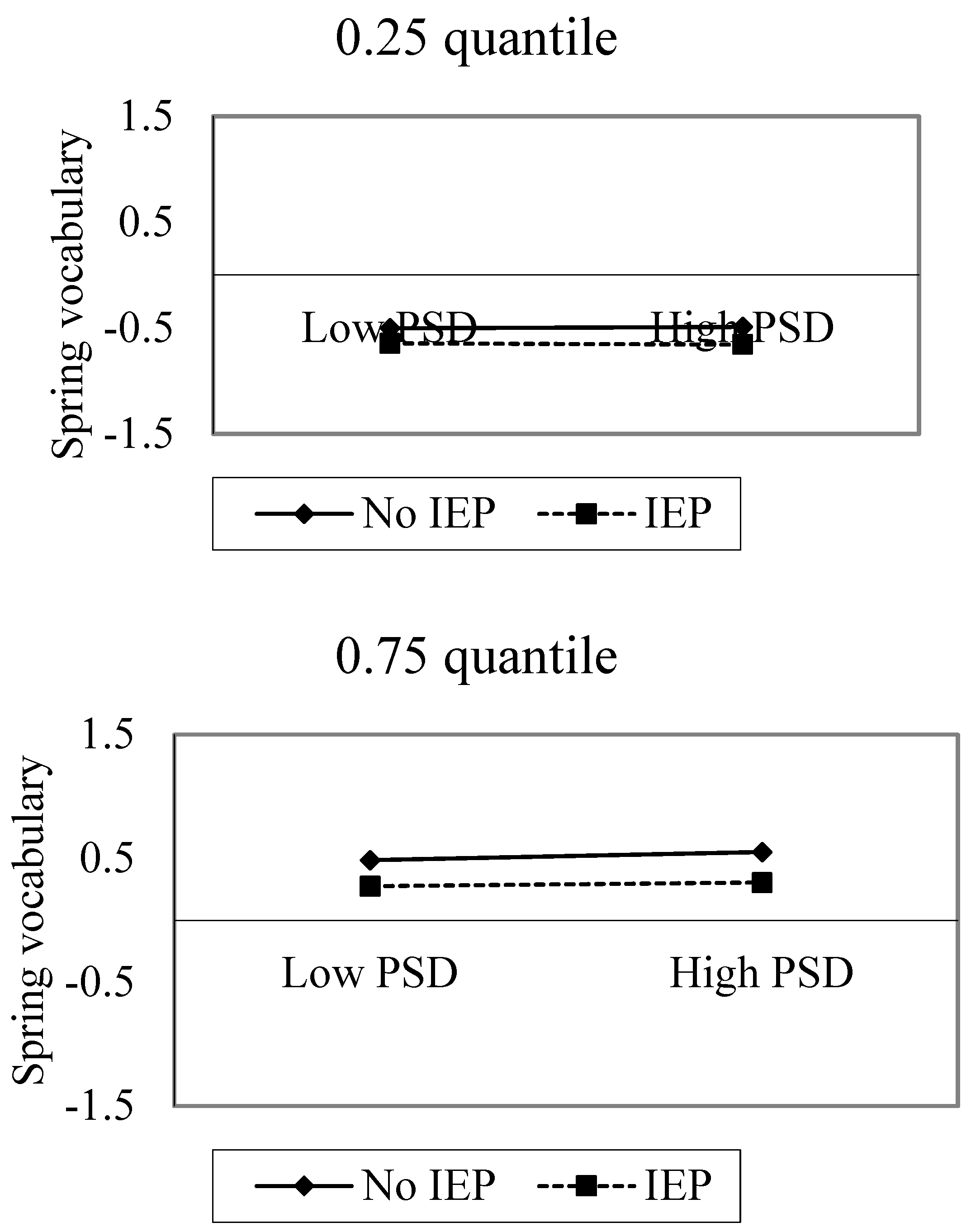
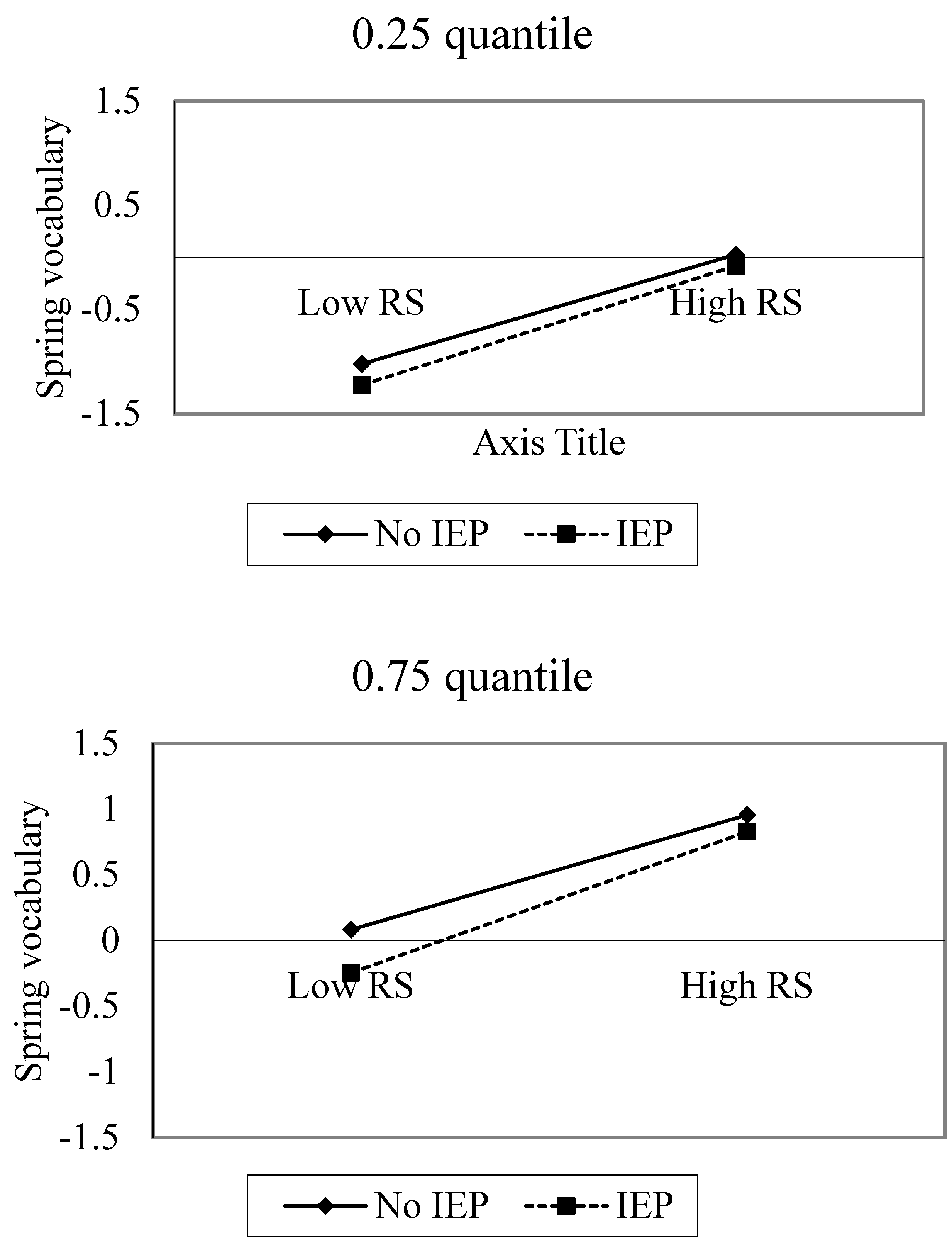
| K | G1 | G2 | Total | State | |
|---|---|---|---|---|---|
| n | 154,220 | 122,435 | 113,262 | 389,917 | |
| Gender | |||||
| % Female | 48.6 | 48.7 | 49.2 | 48.8 | 48.7 |
| % Male | 51.4 | 51.3 | 50.8 | 51.2 | 51.4 |
| Race/Ethnicity | |||||
| % Black | 22.4 | 23.4 | 22.4 | 22.7 | 23.0 |
| % Hispanic | 29.4 | 29.3 | 29.0 | 29.3 | 28.6 |
| % Minority other | 6.3 | 6.3 | 6.6 | 6.4 | 6.0 |
| % White | 41.8 | 41.0 | 42.0 | 41.6 | 42.4 |
| % FRL Eligible | 64.2 | 67.5 | 66.2 | 65.8 | 57.6 |
| % with IEP | 9.9 | 13.7 | 17.2 | 13.2 | 13.2 |
| % Migrant | 2.1 | 1.1 | 1.1 | 1.5 | .5 |
| Variable | n | Mean (SD) | Minimum | Maximum | Skewness | Kurtosis |
|---|---|---|---|---|---|---|
| K Voc (Fall) | 179,031 | 10.09 (4.21) | 0 | 24 | −0.187 | −0.132 |
| K Voc (Spring) | 152,507 | 13.44 (4.43) | 0 | 24 | −0.163 | 0.001 |
| G1 Voc (Fall) | 147,326 | 10.13 (4.15) | 0 | 24 | 0.020 | −0.114 |
| G1 Voc (Spring) | 144,825 | 12.83 (4.48) | 0 | 24 | −0.074 | −0.220 |
| G2 Voc (Fall) | 143,237 | 10.59 (3.59) | 0 | 24 | 0.038 | 0.641 |
| G2 Voc (Spring) | 141,967 | 14.01 (4.28) | 0 | 24 | −0.192 | −0.127 |
© 2018 by the authors. Licensee MDPI, Basel, Switzerland. This article is an open access article distributed under the terms and conditions of the Creative Commons Attribution (CC BY) license (http://creativecommons.org/licenses/by/4.0/).
Share and Cite
Quinn, J.M.; Folsom, J.S.; Petscher, Y. Peer Effects on Vocabulary Knowledge: A Linear Quantile Mixed-Modeling Approach. Educ. Sci. 2018, 8, 181. https://doi.org/10.3390/educsci8040181
Quinn JM, Folsom JS, Petscher Y. Peer Effects on Vocabulary Knowledge: A Linear Quantile Mixed-Modeling Approach. Education Sciences. 2018; 8(4):181. https://doi.org/10.3390/educsci8040181
Chicago/Turabian StyleQuinn, Jamie M., Jessica Sidler Folsom, and Yaacov Petscher. 2018. "Peer Effects on Vocabulary Knowledge: A Linear Quantile Mixed-Modeling Approach" Education Sciences 8, no. 4: 181. https://doi.org/10.3390/educsci8040181
APA StyleQuinn, J. M., Folsom, J. S., & Petscher, Y. (2018). Peer Effects on Vocabulary Knowledge: A Linear Quantile Mixed-Modeling Approach. Education Sciences, 8(4), 181. https://doi.org/10.3390/educsci8040181





